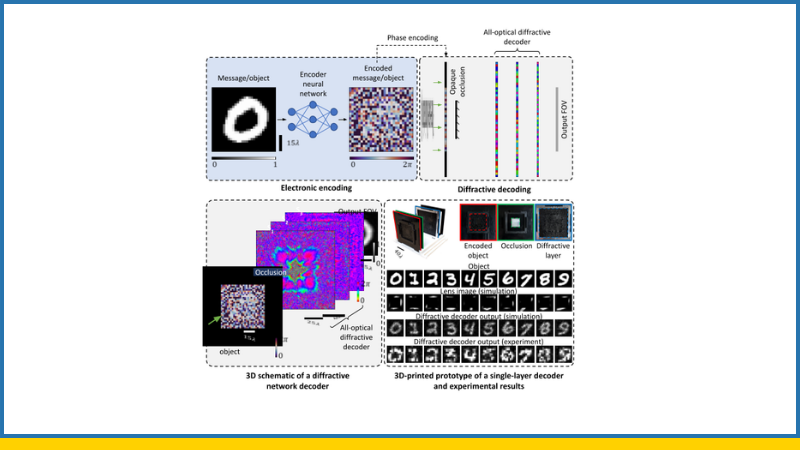UCLA Engineers Find AI-Based Solution to Communicate Information around Opaque Walls
Advance combines an electronic encoder neural network and a material-based decoder to bypass obstructions

Illustration of a UCLA-developed AI-based, combined encoder and decoder framework that can communicate information around opaque walls
Traditional wireless communications have relied on long-wave electromagnetic microwave and radio frequencies, but the growing need for faster data transfer rates has presented performance challenges. Shorter wavelengths, such as the ultraviolet and infrared, provide much wider bandwidths than radio waves or microwaves, but they still require a clear line of sight to transmit information and fail to perform when nontransparent obstruction blocks the light path.
A UCLA research team led by Aydogan Ozcan, the Volgenau Chair for Engineering Innovation and an electrical and computer engineering professor at the UCLA Samueli School of Engineering, has developed a new process to address this problem. The researchers leverage artificial intelligence (AI) to encode messages that can be received by a material-based optical decoder without needing a line of sight, opening new frontiers for non-line-of-sight (NLOS) imaging and communication.
Published in Nature Communications, the UCLA study details a new framework combining active AI-based encoding and passive optical decoding that can mitigate signal degradation caused by opaque obstacles in the transmission path. The encoder makes use of a neural network that allows it to bypass obstacles when transmitting data to a paired material-based decoder. Meanwhile, the decoder material makes use of optical-diffractive decoding — a process in which the received signal passes through a smart material composed of a series of spatially engineered surfaces that passively decode and assemble the information carried in the signal as it passes through at the speed of light.
“By integrating AI into a combined encoding and decoding apparatus, we can expand our capacity for information transfer at optimal speed even when undesired opaque structures obstruct the direct communication channel between the transmitter and the receiver,” said Aydogan Ozcan.
“The wavelengths we rely on today can only accommodate so much speed and data throughput,” Ozcan said. “By integrating AI into a combined encoding and decoding apparatus, we can expand our capacity for information transfer at optimal speed even when undesired opaque structures obstruct the direct communication channel between the transmitter and the receiver.”
Using a 3D-printed diffractive decoder that operates at the terahertz spectrum, the UCLA team demonstrated that its combination of electronic encoding and all-optical decoding method is capable of direct optical communication between the transmitter and the receiver even when the opaque hindrance blocks the transmitter’s field-of-view entirely. Prior NLOS systems were vulnerable to turbulence, causing data transfer to work slowly and consume significant energy. The new scheme can be configured to be misalignment-resilient and highly power-efficient, reaching diffraction efficiencies of greater than 50% at its output. Moreover, the encoder-decoder framework can be jointly trained to accommodate changes in the size and shape of the obstacles without requiring modifications to the structures of either the encoder or decoder.
The process can be scaled for operation in different wavelengths and has the capacity for high-rate data transfer in a wide range of applications, including detecting items hidden inside walls or between metal plates.
Funded by the U.S. Department of Energy’s Office of Basic Energy Sciences and The Institution of Engineering and Technology, the study was conducted in collaboration with Mona Jarrahi, a professor of electrical and computer engineer and holder of UCLA’s Northrop Grumman Endowed Chair in Electrical and Computer Engineering. Both Jarrahi and Ozcan are members of the California NanoSystems Institute at UCLA, where Ozcan is the associate director of entrepreneurship, industry and academic exchange. Ozcan also holds faculty appointments in the Department of Bioengineering and the David Geffen School of Medicine at UCLA.
Other authors of the paper are UCLA Samueli graduate students Md Sadman Sakib Rahman, Tianyi Gan, Emir Arda Deger and Çağatay Işıl, as well as undergraduate student Emir Arda Deger — all members of Ozcan’s and Jarrahi’s research labs at UCLA.
